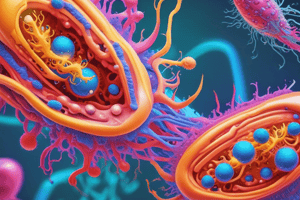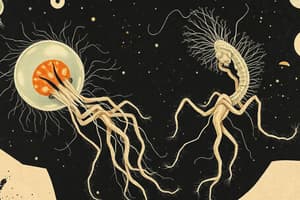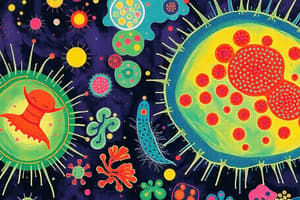Podcast
Questions and Answers
What type of division is characteristic of ciliates?
What type of division is characteristic of ciliates?
- Longitudinal division
- Multiple fission
- Transverse division (correct)
- Binary fission
What is the term for the active, feeding, multiplying stage of most protozoa?
What is the term for the active, feeding, multiplying stage of most protozoa?
- Gametocyte
- Trophozoite (correct)
- Sporozoite
- Metacystic stage
During which process does the nucleus divide multiple times before the cytoplasm divides?
During which process does the nucleus divide multiple times before the cytoplasm divides?
- Gametogenesis
- Binary fission
- Cyst formation
- Schizogony (correct)
In the life cycle of some protozoa, what is the purpose of encystation?
In the life cycle of some protozoa, what is the purpose of encystation?
Which stage results from the fission of a multinucleate schizont in protozoan reproduction?
Which stage results from the fission of a multinucleate schizont in protozoan reproduction?
What type of organism is Opalina?
What type of organism is Opalina?
What is the primary mode of reproduction in the class Sporozoa?
What is the primary mode of reproduction in the class Sporozoa?
Which order within Class Coccidiomorpha includes intracellular parasites of significant medical and veterinary importance?
Which order within Class Coccidiomorpha includes intracellular parasites of significant medical and veterinary importance?
What is a common symptom of infection caused by species of Eimeria?
What is a common symptom of infection caused by species of Eimeria?
During which stage does sexual reproduction occur in the life cycle of Coccidia?
During which stage does sexual reproduction occur in the life cycle of Coccidia?
What is the process called for the formation of oocysts and sporozoites in Coccidia?
What is the process called for the formation of oocysts and sporozoites in Coccidia?
Which species of Coccidia is commonly found in pigs?
Which species of Coccidia is commonly found in pigs?
What is one of the symptoms of acquired toxoplasmosis in adults?
What is one of the symptoms of acquired toxoplasmosis in adults?
Which species is primarily responsible for malaria in humans?
Which species is primarily responsible for malaria in humans?
What is a potential route for Toxoplasma gondii infection in humans?
What is a potential route for Toxoplasma gondii infection in humans?
What type of toxoplasmosis occurs when a fetus is infected during pregnancy?
What type of toxoplasmosis occurs when a fetus is infected during pregnancy?
Which of the following Coccidia affects birds specifically?
Which of the following Coccidia affects birds specifically?
In which geographical area does malaria cause the most deaths?
In which geographical area does malaria cause the most deaths?
What characterizes the extraintestinal stages of Toxoplasma gondii?
What characterizes the extraintestinal stages of Toxoplasma gondii?
Which of the following does not belong to the life cycle of Coccidia?
Which of the following does not belong to the life cycle of Coccidia?
Flashcards are hidden until you start studying
Study Notes
Reproduction in Protozoa
- Division types differ among protozoa: longitudinal in flagellates, transverse in ciliates, and no specific axis in amebas.
- Schizogony is a common asexual reproduction method where the nucleus divides multiple times before the cytoplasm divides into merozoites.
- In apicomplexans like Plasmodium and Toxoplasma, sexual reproduction includes gamete production (gamogony), fertilization into a zygote, encystation into an oocyst, and sporogony forming sporozoites.
Life Cycle Stages
- Protozoans pass through various life stages, with the trophozoite being the active feeding and multiplying stage, often linked to pathogenesis in parasitic species.
- Hemoflagellates have specialized stages (amastigote, promastigote, trypomastigote) based on flagellum presence and kinetoplast position.
- Cysts can multiply internally, as shown in Entamoeba histolytica, where a cyst with one nucleus can yield four metacystic amebas upon excystation.
Class Opalinea
- Opalina is a parasitic protozoan that resides in amphibian digestive systems, characterized by numerous nuclei and mitochondria on its large ciliated body.
Phylum Sporozoa
- Sporozoans are endoparasites, lack locomotor structures, possess a tough cuticle, and primarily reproduce via multiple fission.
- This phylum includes Gregarinina (parasites of invertebrates) and Coccidiomorpha (important for medical and veterinary fields).
Class Coccidiomorpha
- Coccidia are key intracellular parasites, and Eimeria is associated with severe diseases in domestic animals, often leading to diarrhea or dysentery.
- The life cycle encompasses asexual reproduction in intestinal cells, sexual reproduction leading to oocyst formation, and sporogony outside the host.
Eimeria and Isospora
- Coccidiosis primarily refers to infections caused by Eimeria or Isospora; symptoms can vary, with some causing severe gastrointestinal issues.
- More than 90% of coccidial deaths occur in sub-Saharan Africa, highlighting Malaria's widespread impact, predominantly caused by Plasmodium species.
Toxoplasma gondii
- This parasite has a complex life cycle, producing extraintestinal stages that can infect various animals including humans.
- Acquired toxoplasmosis manifests in adults as lymph node swelling and flu-like symptoms, while congenital toxoplasmosis can affect fetuses during pregnancy.
Phylum Ciliophora
- Ciliates utilize cilia for locomotion, are often aquatic, and display diverse morphological adaptations.
- Asexual reproduction occurs via binary fission, while conjugation facilitates genetic exchange among individuals.
- Diseases associated with ciliates include balantidiasis, caused by Balantidium coli, impacting the digestive tract with symptoms of colitis.
Specific Ciliate Diseases
- Chilodonella cyprini infects fish and causes skin discoloration and gill damage.
- Trichodina is known for its adhesive denticles, affecting aquatic animals.
- Ichthyophthirius multifiliis causes "white spot disease," significantly affecting fish populations globally.
Microsporidia and Glugea
- Microsporidia, especially Glugea, infect fish and can lead to severe health issues due to cyst formation and eventual bloating of infected organs.
Importance of Protozoa
- Protozoa are omnipresent, with many species residing in diverse habitats, impacting higher animals and ecosystems through their life cycles and interactions.
Studying That Suits You
Use AI to generate personalized quizzes and flashcards to suit your learning preferences.




